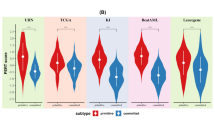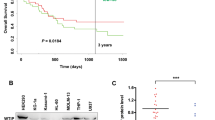Abstract
In this study, we investigated the role of i nositol polyphosphate-4-phosphatase, type-II (INPP4B) in acute myeloid leukemia (AML). We observed that AML patients with high levels of INPP4B (INPP4Bhigh) had poor response to induction therapy, shorter event-free survival and shorter overall survival. Multivariate analyses demonstrated that INPP4Bhigh was an independent predictor of poor prognosis, significantly improving current predictive models, where it outperformed conventional biomarkers including FLT3-ITD and NPM1. Furthermore, INPP4Bhigh effectively segregated relative risk in AML patients with normal cytogenetics. The role of INPP4B on the biology of leukemic cells was assessed in vitro. Overexpression of INPP4B in AML cell lines enhanced colony formation potential, recapitulated the chemotherapy resistance observed in AML patients and promoted proliferation in a phosphatase-dependent, and Akt-independent manner. These findings reveal that INPP4Bhigh has an unexpected role consistent with oncogenesis in AML, in contrast to its previously reported tumor-suppressive role in epithelial cancers. Overall, we propose that INPP4B is a novel prognostic biomarker in AML that has potential to be translated into clinical practice both as a disease marker and therapeutic target.
This is a preview of subscription content, access via your institution
Access options
Subscribe to this journal
Receive 12 print issues and online access
$259.00 per year
only $21.58 per issue
Buy this article
- Purchase on Springer Link
- Instant access to full article PDF
Prices may be subject to local taxes which are calculated during checkout






Similar content being viewed by others
References
Lowenberg B, Downing JR, Burnett A Acute myeloid leukemia. N Engl J Med 1999; 341: 1051–1062.
Fernandez HF, Sun Z, Yao X, Litzow MR, Luger SM, Paietta EM et al. Anthracycline dose intensification in acute myeloid leukemia. N Engl J Med 2009; 361: 1249–1259.
Walter RB, Othus M, Burnett AK, Löwenberg B, Kantarjian HM, Ossenkoppele GJ et al. Resistance prediction in AML: analysis of 4,601 patients from MRC/NCRI, HOVON/SAKK, SWOG, and MD Anderson Cancer Center. Leukemia 2014; 29: 312–320.
Balla T . Phosphoinositides: tiny lipids with giant impact on cell regulation. Physiol Rev 2013; 93: 1019–1137.
Park S, Chapuis N, Tamburini J, Bardet V, Cornillet-Lefebvre P, Willems L et al. Role of the PI3K/AKT and mTOR signaling pathways in acute myeloid leukemia. Haematologica 2010; 95: 819–828.
Martelli AM, Nyåkern M, Tabellini G, Bortul R, Tazzari PL, Evangelisti C et al. Phosphoinositide 3-kinase/Akt signaling pathway and its therapeutical implications for human acute myeloid leukemia. Leukemia 2006; 20: 911–928.
Norris FA, Atkins RC, Majerus PW . The cDNA cloning and characterization of inositol polyphosphate 4-phosphatase type II. Evidence for conserved alternative splicing in the 4-phosphatase family. J Biol Chem 1997; 272: 23859–23864.
Fedele CG, Ooms LM, Ho M, Vieusseux J, O’Toole SA, Millar EK et al. Inositol polyphosphate 4-phosphatase II regulates PI3K/Akt signaling and is lost in human basal-like breast cancers. Proc Natl Acad Sci USA 2010; 107: 22231–22236.
Gewinner C, Wang ZC, Richardson A, Teruya-Feldstein J, Etemadmoghadam D, Bowtell D et al. Evidence that inositol polyphosphate 4-phosphatase type II is a tumour suppressor that inhibits PI3K signaling. Cancer Cell 2009; 16: 115–125.
Hodgson MC, Shao LJ, Frolov A, Li R, Peterson LE, Ayala G et al. Decreased expression and androgen regulation of the tumor suppressor gene INPP4B in prostate cancer. Cancer Res 2011; 71: 572–582.
Perez-Lorenzo R, Gill KZ, Shen C-H, Zhao FX, Zheng B, Schulze H-J et al. A tumor suppressor function for the lipid phosphatase INPP4B in melanocytic neoplasms. J Invest Dermatol 2014; 134: 1359–1368.
Stjernström A, Karlsson C, Fernandez OJ, Söderkvist P, Karlsson MG, Thunell LK . Alterations of INPP4B, PIK3CA and pAkt of the PI3K pathway are associated with squamous cell carcinoma of the lung. Cancer Med 2014; 3: 337–348.
The Cancer Genome Atlas Research Network. Comprehensive molecular portraits of human breast tumours. Nature 2012; 490: 61–70.
Westbrook TF, Martin ES, Schlabach MR, Leng Y, Liang AC, Feng B et al. A genetic screen for candidate tumor suppressors identifies REST. Cell 2005; 121: 837–848.
Barnache S, Le Scolan E, Kosmider O, Denis N, Moreau-Gachelin F . Phosphatidylinositol 4-phosphatase type II is an erythropoietin-responsive gene. Oncogene 2006; 25: 1420–1423.
Franke TF, Kaplan DR, Cantley LC, Toker A . Direct regulation of the Akt proto-oncogene product by phosphatidylinositol-3,4-bisphosphate. Science 1997; 275: 665–668.
Frech M, Andjelkovic M, Ingley E, Reddy KK, Falck JR, Hemmings BA . High affinity binding of inositol phosphates and phosphoinositides to the pleckstrin homology domain of RAC/protein kinase B and their influence on kinase activity. J Biol Chem 1997; 272: 8474–8481.
Klippel A, Kavanaugh WM, Pot D, Williams LT . A specific product of phosphatidylinositol 3-kinase directly activates the protein kinase Akt through its pleckstrin homology domain. Mol Cell Biol 1997; 17: 338–344.
Salmena L, Shaw P, Fan I, McLaughlin JR, Rosen B, Risch H et al. Prognostic value of INPP4B protein immunohistochemistry in ovarian cancer. Eur J Gynaecol Oncol 2015; doi:10.12892/ejgo2741.2015.
Lundin C, Hjorth L, Behrendtz M, Nordgren A, Palmqvist L, Andersen MK et al. High frequency of BTG1 deletions in acute lymphoblastic leukaemia in children with down syndrome. Genes Chromosomes Cancer 2012; 51: 196–206.
Ross ME, Zhou X, Song G, Shurtleff SA, Girtman K, Williams WK et al. Classification of pediatric acute lymphoblastic leukemia by gene expression profiling. Blood 2003; 102: 2951–2959.
Budczies J, Klauschen F, Sinn B V, Győrffy B, Schmitt WD, Darb-Esfahani S et al. Cutoff Finder: a comprehensive and straightforward Web application enabling rapid biomarker cutoff optimization. PLoS One 2012; 7: e51862.
Van Galen P, Kreso A, Mbong N, Kent DG, Fitzmaurice T, Chambers JE et al. The unfolded protein response governs integrity of the haematopoietic stem-cell pool during stress. Nature 2014; 510: 268–272.
Metzeler KH, Hummel M, Bloomfield CD, Spiekermann K, Braess J, Sauerland M-C et al. An 86-probe-set gene-expression signature predicts survival in cytogenetically normal acute myeloid leukemia. Blood 2008; 112: 4193–4201.
Bullinger L, Rücker FG, Kurz S, Du J, Scholl C, Sander S et al. Gene-expression profiling identifies distinct subclasses of core binding factor acute myeloid leukemia. Blood 2007; 110: 1291–1300.
The Cancer Genome Atlas Research Network. Genomic and epigenomic landscapes of adult de novo acute myeloid leukemia. N Engl J Med 2013; 368: 2059–2074.
Verhaak RGW, Wouters BJ, Erpelinck CAJ, Abbas S, Beverloo HB, Lugthart S et al. Prediction of molecular subtypes in acute myeloid leukemia based on gene expression profiling. Haematologica 2009; 94: 131–134.
Baldus CD, Bullinger L . Gene expression with prognostic implications in cytogenetically normal acute myeloid leukemia. Semin Oncol 2008; 35: 356–364.
Grimwade D, Walker H, Oliver F, Wheatley K, Harrison C, Harrison G et al. The importance of diagnostic cytogenetics on outcome in AML: analysis of 1,612 patients entered into the MRC AML 10 trial. The Medical Research Council Adult and Children’s Leukaemia Working Parties. Blood 1998; 92: 2322–2333.
Foran JM . New prognostic markers in acute myeloid leukemia: perspective from the clinic. Hematology Am Soc Hematol Educ Program 2010; 2010: 47–55.
Bago R, Malik N, Munson MJ, Prescott A, Davies P, Sommer EM et al. Characterisation of VPS34-IN1, a selective inhibitor of Vps34 reveals that the phosphatidylinositol 3-phosphate binding SGK3 protein kinase is a downstream target of class III PI-3 kinase. Biochem J 2014; 463: 413–427.
Gasser JA, Inuzuka H, Lau AW, Wei W, Beroukhim R, Toker A . SGK3 mediates INPP4B-dependent PI3K signaling in breast cancer. Mol Cell 2014; 56: 595–607.
Acknowledgements
We thank Dr John Dick and Dr Norman Iscove for critical reagents and invaluable advice, and Dr Pier Paolo Scaglioni, Dr Rob Laister and Dr Michael Jain for insightful discussions, Dr Joanne Kotsopoulos for statistical analysis, and Raffi Salmena for colony counting. Pi-Glo: Universal Bioluminescent Phosphatase Assay system was a kind gift from Promega. LS is funded in part by a Human Frontier Career Development Award (CDA-00079/2011). This work was supported in part by a Leukemia and Lymphoma Society of Canada Grant (317359/2013) to LS.
Author information
Authors and Affiliations
Corresponding author
Ethics declarations
Competing interests
The authors declare no conflict of interest.
Additional information
Supplementary Information accompanies this paper on the Leukemia website
Supplementary information
Rights and permissions
About this article
Cite this article
Dzneladze, I., He, R., Woolley, J. et al. INPP4B overexpression is associated with poor clinical outcome and therapy resistance in acute myeloid leukemia. Leukemia 29, 1485–1495 (2015). https://doi.org/10.1038/leu.2015.51
Received:
Revised:
Accepted:
Published:
Issue Date:
DOI: https://doi.org/10.1038/leu.2015.51
This article is cited by
-
PIM2 and NF-κβ gene expression in a sample of AML and ALL Egyptian patients and its relevance to response to treatment
Egyptian Journal of Medical Human Genetics (2021)
-
Expression and functional characterization of INPP4B in gallbladder cancer patients and gallbladder cancer cells
BMC Cancer (2021)
-
Prognostic Impact of PPP2R5C Gene Expression in Adult Acute Myeloid Leukemia Patients with Normal Cytogenetics
Indian Journal of Hematology and Blood Transfusion (2020)
-
Role of PI3K/AKT pathway in cancer: the framework of malignant behavior
Molecular Biology Reports (2020)
-
IRF2–INPP4B-mediated autophagy suppresses apoptosis in acute myeloid leukemia cells
Biological Research (2019)



